人教版《新高中英语》教材的课堂教学探讨与交流
文档属性
| 名称 | 人教版《新高中英语》教材的课堂教学探讨与交流 |  | |
| 格式 | rar | ||
| 文件大小 | 2.4MB | ||
| 资源类型 | 教案 | ||
| 版本资源 | 人教版(新课程标准) | ||
| 科目 | 英语 | ||
| 更新时间 | 2010-04-16 17:16:00 | ||
图片预览

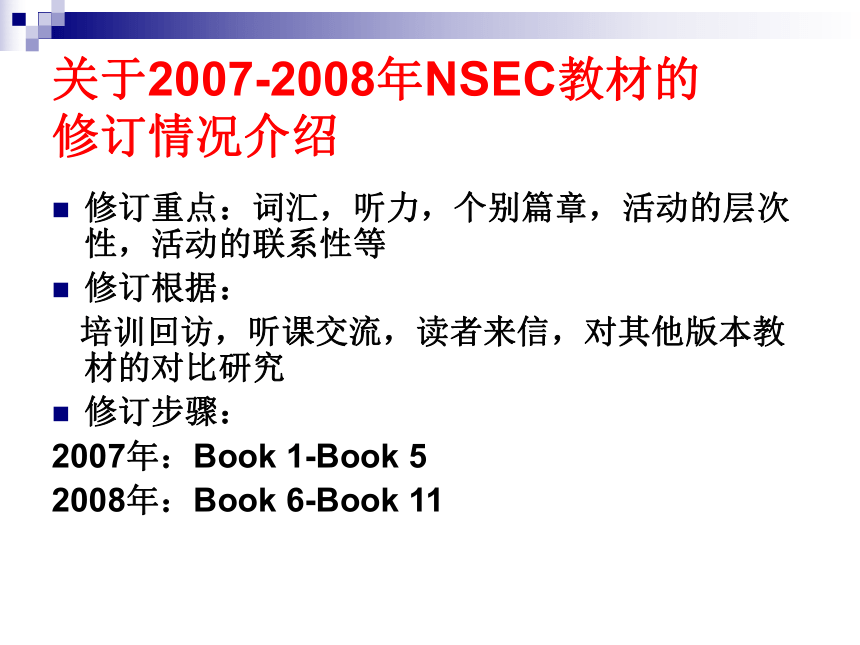
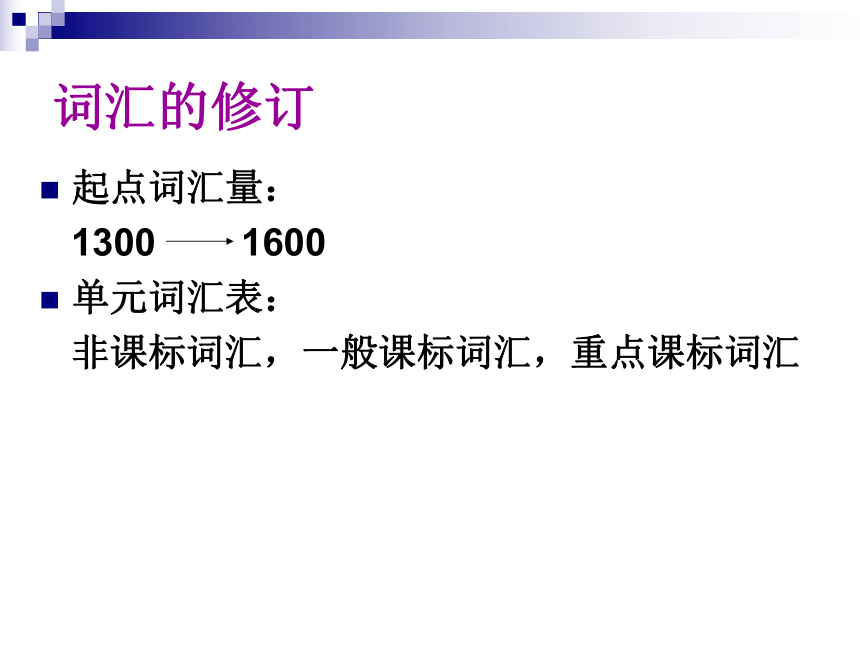
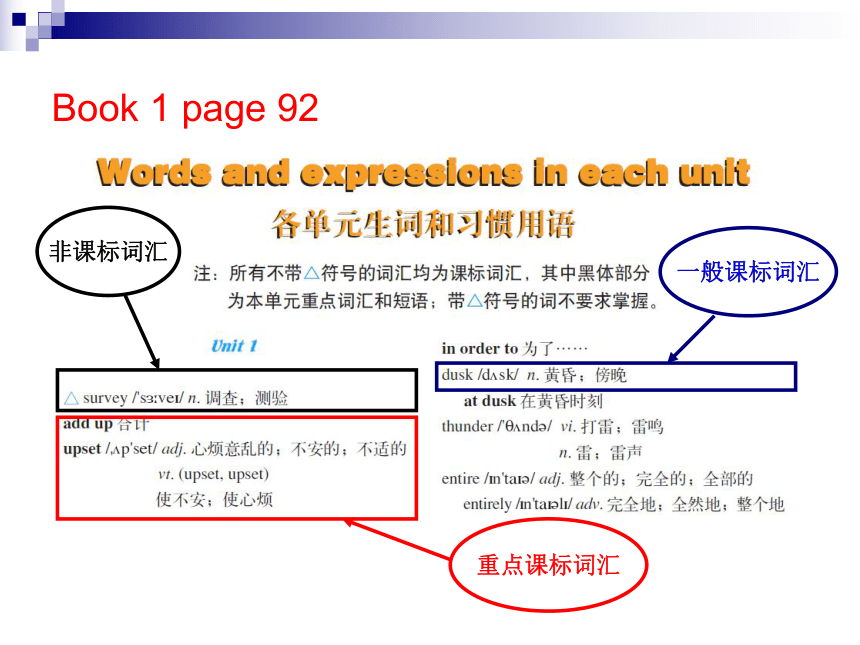
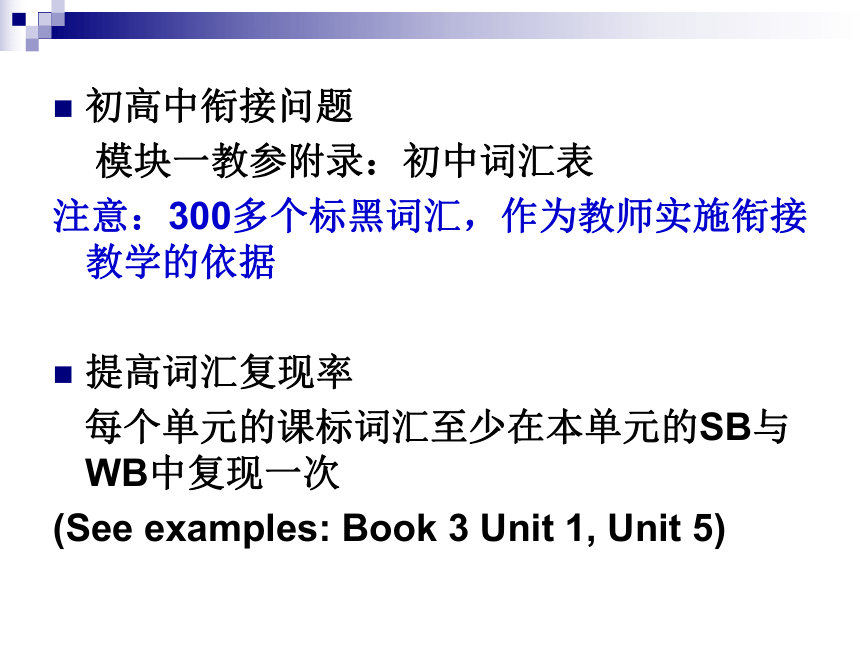
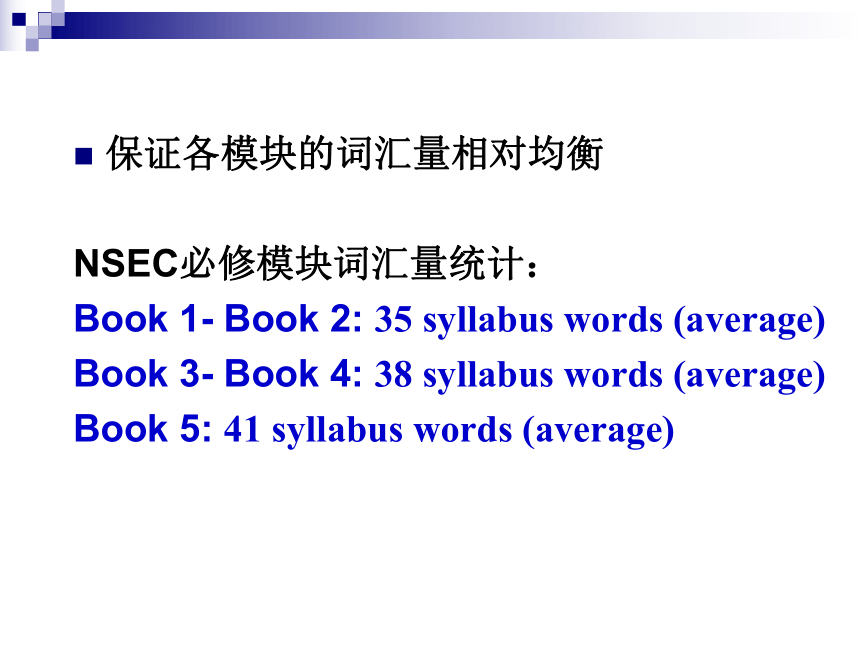
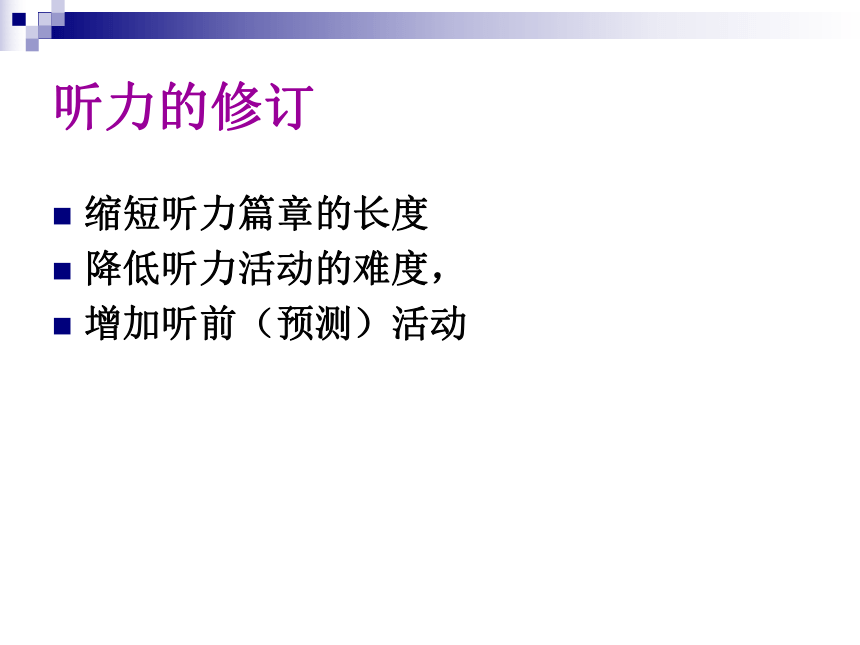
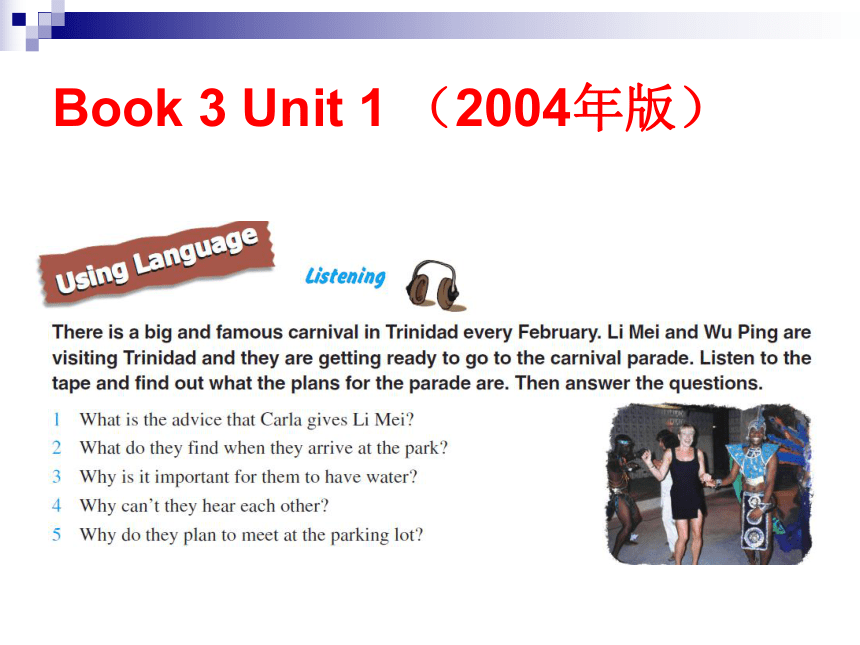
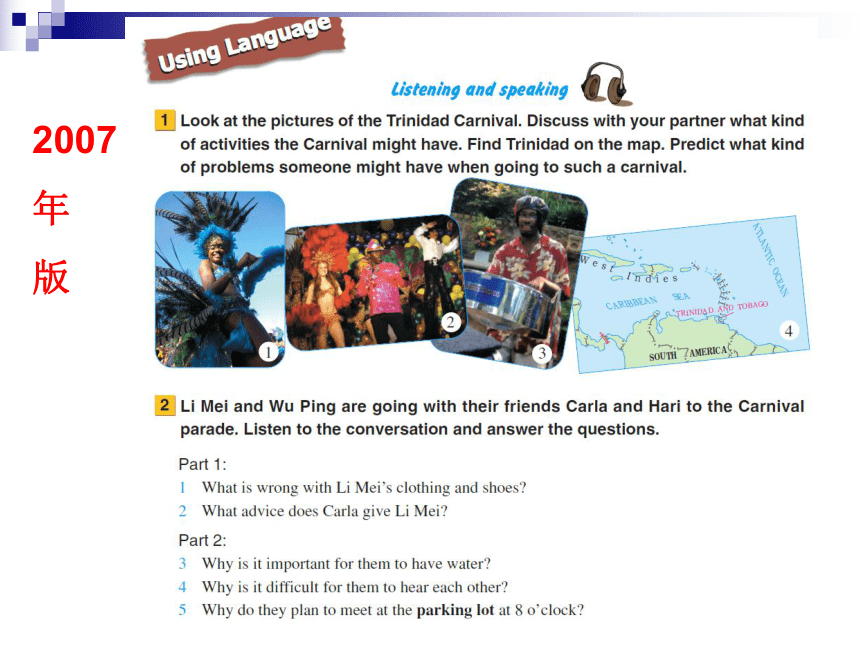
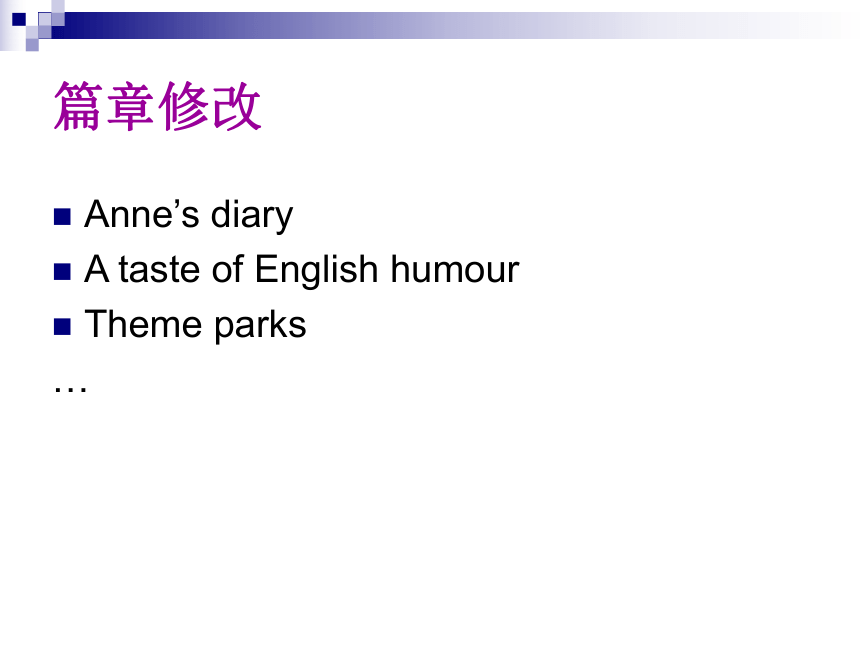
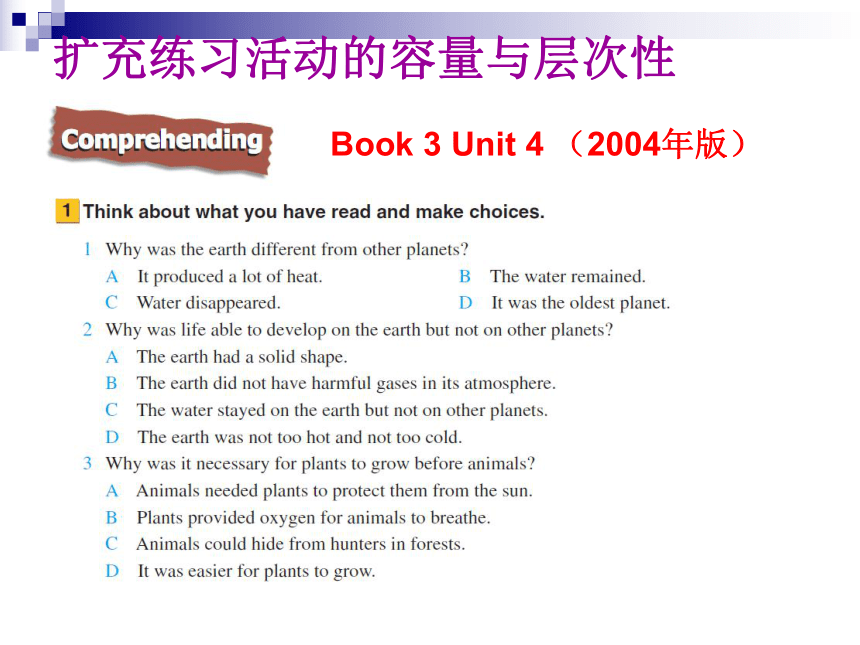
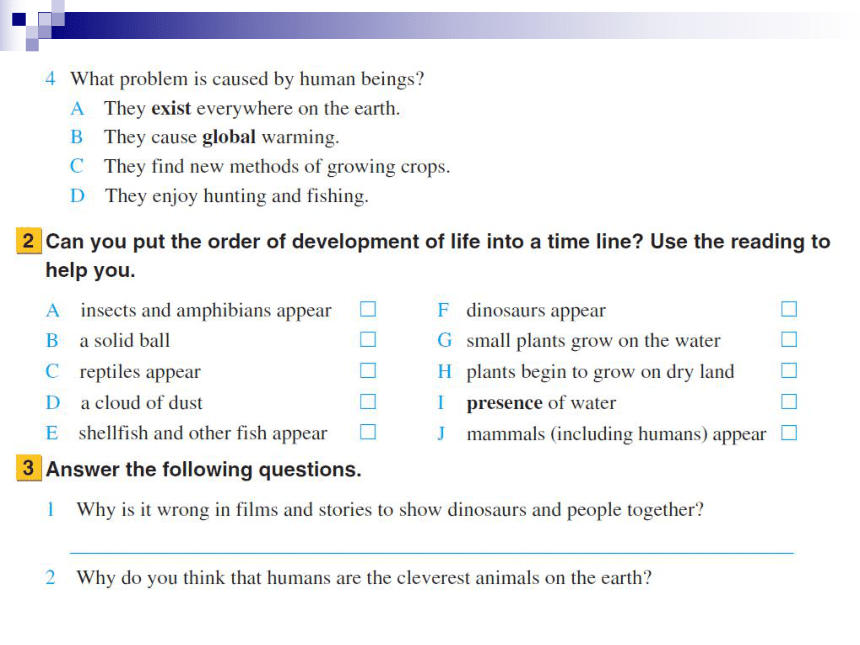
文档简介
课件70张PPT。人教版《新高中英语》教材的课堂教学探讨与交流—— 2010年广东五地市高中英语学科回访交流中学英语编辑室 肖菲
人民教育出版社关于2007-2008年NSEC教材的 修订情况介绍修订重点:词汇,听力,个别篇章,活动的层次性,活动的联系性等
修订根据:
培训回访,听课交流,读者来信,对其他版本教材的对比研究
修订步骤:
2007年:Book 1-Book 5
2008年:Book 6-Book 11
词汇的修订起点词汇量:
1300 1600
单元词汇表:
非课标词汇,一般课标词汇,重点课标词汇Book 1 page 92一般课标词汇非课标词汇重点课标词汇初高中衔接问题
模块一教参附录:初中词汇表
注意:300多个标黑词汇,作为教师实施衔接教学的依据
提高词汇复现率
每个单元的课标词汇至少在本单元的SB与WB中复现一次
(See examples: Book 3 Unit 1, Unit 5)
保证各模块的词汇量相对均衡
NSEC必修模块词汇量统计:
Book 1- Book 2: 35 syllabus words (average)
Book 3- Book 4: 38 syllabus words (average)
Book 5: 41 syllabus words (average)听力的修订缩短听力篇章的长度
降低听力活动的难度,
增加听前(预测)活动
Book 3 Unit 1 (2004年版)2007
年
版篇章修改Anne’s diary
A taste of English humour
Theme parks
…
扩充练习活动的容量与层次性Book 3 Unit 4 (2004年版)Book 3 Unit 4 (2007年版)增强各项技能活动的联系性如:Book 1 Unit 1 Using language
高中英语课堂教学中应该注意的 几个问题导入
阅读教学中存在的问题
课堂活动的设计
如何处理篇章中的新词汇
1 如何处理好单元的“热身”或“导入”?处理“热身”或“导入”应投入多少时间?
“热身”或“导入”教学中可能出现哪些问题?如何解决?
“热身”部分教学现状分析案例“热身”教学是否得以实施?
“热身”教学的时间投入有多少?
“热身”部分的课堂教学方法是否合理?
“热身”教学效果如何?
调查对象:浙江西部一所省三级重点中学。该校面向城镇和农村招生,以农村学生为主。高一和高二共13个班292名学生,13位老师。修订版SEFC“热身”教学的调查结果对其重要性的认识
(98.5%)
教学时间的投入 关于“热身”教学方法的调查结果24.3%
45.9%
8.6%
21.2%38.5%
61.5%
15.4%
38.5%关于“热身”教学效果的调查结果症结
在“导入”过程中,许多学生处于被动状态,教学未能激发学生对新单元的学习兴趣和参与活动的积极性!
学生:
英语基础薄弱,词汇量不够
语言技能不强,锻炼机会不多
缺乏对背景知识的了解
缺乏自信或在课堂上羞于开口
教材:
活动或问题难度太高或过低
活动或问题设计缺乏可操作性
内容脱离学生的生活实际
问题与主课文内容关系不密切
学生不熟悉图片的内容,感到无话可说
“热身”或“导入”教学中是否也存在问题?
(以下案例供大家观察探讨)Topic: My new teachers
Lesson plan: Listening (criteria for a good teacher) and reading (introduction of three teachers) (教材内容摘要如下)预设的问题是否合理?是否考虑了学生的心理和思维方式?Step 1: Lead in
T: Hello, boys and girls. Nice to meet you! I am your new teacher. Now look at me! What do you think about me? Could you use some adjectives to describe me?INTRODUCTION
1 Look at these words. Decide if they are positive or negative.
amusing energetic funny intelligent kind lively stupid
nervous organized patient popular serious shy strict
2 Use some of the words in activity 1 to describe people you know.
3 Listen and tick the statements that you agree with …
案例1Topic: Canada— “The Truth North”
Lesson plan: Listening and speaking (WB Listening: a comparison between Canada and China)
Step 1 Lead in
1 Teacher shows some pics (maple tree, national flag, map of Canada, map of China) and let Ss talk about some general information about Canada and China(size, position, oceans).
2 Teacher ask Ss:
If you are asked to compare Canada with another country, which country would you choose?导入活动是否有针对性?导入的目的是什么?案例2Topic: Life in the future
Lesson: Listening (a letter from the future) and speaking
Step 1: Lead in (12 minutes)
1 Questions: How did people travel in the past? What about now? What about in the future?
2 Let Ss watch a piece of video (Shenzhou VII into space)
T: So how do you think people will travel in the future?
Ss: By rockets.
T: I think …Do you agree?
Ss: Yes.多媒体视频的运用是否得当?
导入的时间与效果是否成正比?
学生和教师的角色?案例4Topic: First aid
Lesson: Revision
Step 1: Lead in
1 Teacher ask questions:
Where would you go if you are really sad?
Suppose you are studying abroad, what would you miss most?
Is home the safest place? What kind of accidents may happen at home?
2 Let Ss describe some pictures (snakebite, bleeding, burns, sprained ankle)设计问题是否脱离教学中心?案例3“导入”或“热身”教学中可能存在的问题设计脱离教学主题或中心
设计枯燥乏味
预设问题束缚学生的思维或对学生的问答缺乏应对能力
脱离学生的生活实际
导入环节教师唱独角戏
导入部分拖沓冗长
教学步骤不衔接,起不到“导入”的作用
改进教学的建议合理取舍教材内容
发挥学生参与“导入”活动的积极性
采取多样的教学手段 (多媒体)
巧妙地联系学生的生活
内容联系时事和学生的兴奋点
Topic: My new teachers
Lesson: Listening and reading
Step 1: Lead in
1 Teacher asks questions:
Do you remember your first teacher? Who is your favorite teacher? Can you tell me something about him or her?
2 Word competition: Divide the whole class into two groups. Ss come to the blackboard to write as many adjectives as possible to describe a popular teacher and an unpopular teacher. 案例53 Read the adjectives after the teacher.注重培养学生分类归纳的能力,记忆词汇音形义相结合Topic: English around the world
Lesson plan: Reading
Step 1 Lead in
Let Ss watch a short video (2 mins) which shows how enthusiastic Beijing people were to learn English before the Olympics. Teacher briefly talks about the importance of learning English.
Teacher provides a world map which is marked with names of countries. In pairs students list the countries that use English as an official language (eg India, Malaysia, Singapore, South Africa).
Questions:
Is English used as an official language in China?
Which country do you think has the most English learners?
案例6Topic: Canada— “The True North”
Lesson plan: Reading
Lead-in
Teacher shows a piece of video about Canada (加拿大旅游宣传片)and ask Ss:
Which country is it about?
What do you expect to see in Canada?
A small quiz about Canada (introducing national flag, capital, animal, lakes, languages, position, size, etc)What warming up activities would you design for Module 3 Unit 1?Topics
Student’s interests
Vocabulary
Grammar
Reading comprehension activities
Speaking
Cooperative learning
…Activity 2:Which is your favourite festival? Give your reasons.
Which festival would you like to experience? Why?
(vocabulary, grammar)Activity 1:In groups brainstorm the festivals you know about or you might have heard of. Make a list and try to classify them into different categories.
Chinese festivals/western festivals/African festivals
Festivals to celebrate …
(topic, reading passage)Activity 3:Get into groups. Each student must think of a festival and briefly describe it to your group members. The other members ask questions and try to guess what festival it is.
(interest, vocabulary, cooperative learning)2 《新高中英语》的阅读教学应注意哪些问题?(1)学生课前是否需要预习?
是否预习要视课文难易程度来决定。就课堂阅读教学来说,一般不主张学生预习课文。预先了解课文内容和生词不利于培养学生的阅读技能,如快速阅读理解大意、猜测生词与短语、读前预测、结局预测等。
(2)阅读教学过程中如何处理语言点?
传统做法:
扫除语言障碍,达到快速阅读和理解
不利于培养学生自主探究学习的能力
新课程背景下的阅读教学:
词汇:根据语篇词汇的难度和重要性确定教学方式
语法:“先感性,后理性”,学生带着新语言点去直接理解语义,自己去感知并试图理解新的语言项目,然后教师再讲解语言点。因此,语言点的教学应放在阅读后进行。(3) 阅读课上的主要活动Have students read the texts
Let students do some activities and exercises involving the reading texts√(4)阅读微技能及策略的培养Reading strategies:
Activating prior knowledge
Predicting
Skimming
Scanning
Guessing meaning of unknown words
Recognizing text types
Identifying topics and main ideas
Word recognition exercises (not really a strategy)To develop/improve the students’ reading skills
To get the students familiar with vocabulary
Students will underline the topic sentence in each paragraph.
Students will write three inferential questions for the passage that is presented.
Students will be able to skim to find the main idea
of the passage. 1 明确的教学活动目标3 课堂教学活动设计有什么原则?Ten Question Syndrome
“十问题综合症”
K-W-L模式:
What do I Know?
What do I Want to know?
What have I Learned? 2 活动与练习应从学生实际出发Input processing: Input-intake-output
Patten (1993)
Present one thing at a time
Keep meaning in focus
Move from sentence to connected discourse
Use both oral and written input
Have the learner “do” something with the input
…
(See the learning plan by Diao Weichen)教师的角色定位:
“Are you a coach or a judge?”
脚手架原则(scaffolding)
“What difficulties do the students have?”
(see the lesson plan by Pan Youfei)
语言输入→语言输出
3 活动设计应以“教”而非“测”为目的4 活动的多样性与逻辑联系性 (to maintain interest, motivation, and pace)Individual work
Pair work
Group work
Class work
Cooperative learning:角色分工,评价
5 活动指令语应明确清晰 示例:What problems can you find from the following teaching instructions?
Now please use some adjectives to introduce somebody.
Now please use as many adjectives as you can to describe a popular teacher and an unpopular teacher.Please turn to page 11.Look at the screen, here are some pictures. Please describe them using the expressions below them.
Scan the text to get the general idea of the text. Now listen to the tape.
Can you find other information about Murray’s life?
…
课堂教学活动与练习设计自查参考:
PURPOSE: Is the purpose clearly defined?
TYPE: Does the type of exercise/activity effectively and economically accomplish the purpose?
CONTENT: Is the ratio of language given/learner task economic?
Are instructions to learners clear?
INTEREST: Is it interesting?
AUTHENTICITY: Is it a meaningful task? Is it challenging?
DIFFICULTY: Does it contain distracting difficulty?
(Moore J, 1980)
词汇教学面临的问题词汇教学教什么?
词汇教学如何在课堂中有效实施?
词汇学习只依靠课堂教学可以吗?
What?What words are to be taught?
What aspects of a word are to be taught?
What strategies are to be taught?All words are not created equal.Four major groups
Syllabus words & non-syllabus wordsHigh frequency words: 2,000 word families
Low frequency words
Academic words
Technical words
—— Paul Nation NSEC无论在词簇、词形还是词的搭配和使用上都与基于大型语料库最常用的2500个词汇编写的CCEC教材相当吻合,反映了我国课改后的NSEC在广度和深度上基本呈现了最常用的英语词汇及其最典型的使用范式。
——何安平教授教材中的生词分为课标词和非课标词,其中课标词中还有一些重点推荐词。What aspects of a word ?If you know a word, it means:
You know how often it appears in oral or written language;
You know its fun_ction in a context;
You know which family it belongs to;
You can associate it with other words;
You know its other meanings;
You know which words it might co-occur with.
How?建议一:分层次处理
建议二:与听说读写各种课型相结合
建议三:注意词汇的复现和归纳
建议四:多样的词汇教学活动形式
Strategies to be taughtPronunciation, form, meaning combined
Guessing words from the context:实例
A knowledge of word formation: M4U5
Using English-English dictionaries
Skills of memorizing words
How deeply you process the word
How frequent you meet the word
L1 translation L2 explanation
L2 output建议一:分层次处理单元教学前,教师对词汇进行分类,采取不同的教学方法
High frequency—low frequency—specialized (Nation)
topical words—non-topical but important words
How to deal with vocabulary in an intensive reading textJustifying procedures
Reasons:
It is a high frequency word or will occur in other texts.
It is a useful technical word.
It is a low frequency word.
It is important for the message of the text.
It is not important for the message of the text.
It has useful parts.
It is easy to guess from context.
It is like a first language word. Justifications for Procedures for Dealing with Words in TextsPaul Nation, Managing Vocabulary Learning 中小学英语教师发展丛书:词汇教学设计建议二:与听说读写各种课型相结合Learning from meaning-focused input: listening, reading
Learning from meaning-focused output: speaking, writing
Language-focused learning: important words, strategies, grammar
Developing fluency: repetition
( Nation )建议三:注意词汇的复现和归纳Lexico-semantic theory
a net work of associations, a web-like structure of interconnected links (Aitchison, 1987)
Connect the word with already known words, the links is created, the learning takes place (S?kmen ) 当词汇增加到一定程度时,头脑就会建立一个系统,使词汇有机地组织起来,以便提取。1 Put the words into three lists.
What other words can you think of to put into this spider?
How many words for time/colour/… do you have?
Try to work out the meaning of these words beginning with “multi-”.教材词汇学习实例 (Book 1 Unit 5)Grouping them according to theme/topic such as
国家、政权、法律republic,nationalism, law, principle, advise, vote,
犯罪 law, put in prison, guard, criminal, be sentenced to …,
人品 hero, great, famous, quality, willing, active, not lose heart when being in trouble …,
战争与和平 invader, fight, violence, blow up, terror, fear, be worry about, cruelty, peaceful … (meaningful association)
(广州陈艳华老师)M6U1 ArtNouns related to the topic
Adjectives to describe artΔThe Renaissance, Δmasterpiece, Δ impressionist/impressionism Clay, Δbronze, marble, ΔcanvasSculptor/sculpture, gallery, exhibition, figure, shadow, techniqueRealistic, abstract, conventional, typical, evident, superb, ridiculous, controversial, specific, contemporary, permanent Adjectives to describe artistsDelicate, aggressive, fragile, faithful, Important verbsAdopt, possess, attempt, predict, carve, appeal贯穿于听说读写各项活动中去Dual coding theoryLearning is aided when materials is made concrete within the conceptual range of the learners
Create a range of 5-16 encounters with a word in order for student to truly acquire it
lexical chunksThe most fundamental guiding principle (for) those who are anxious to be proficient in foreign conversation… is this: Memorizing perfectly the largest number of common and useful word-groups!” Palmer (1925)
As a way of quickly developing fluency and of picking up native-like expressions, groups of words should be learned as units.
Nation (2003)lexical chunksPolywords:一个单词以上组成的固定短语
Collocates:词项在长期使用中逐步形成的一种同现(co-occurrence)
lexical: heavy rain, heavy smoker
grammatical: intend to do, good at
Institutional utterances:形式固定或半固定,并具有固定的语用功能的组合。
Sentence frames and heads:用于书面语中。
母语学习的启发???动词归纳建议四:多样的词汇教学活动形式Bingo
CL approach
Games
课外词汇学习的重要性Extensive reading
motivation
Level of difficulty
Frequency
Collections Thank you! xiaof@pep.com.cn
人民教育出版社关于2007-2008年NSEC教材的 修订情况介绍修订重点:词汇,听力,个别篇章,活动的层次性,活动的联系性等
修订根据:
培训回访,听课交流,读者来信,对其他版本教材的对比研究
修订步骤:
2007年:Book 1-Book 5
2008年:Book 6-Book 11
词汇的修订起点词汇量:
1300 1600
单元词汇表:
非课标词汇,一般课标词汇,重点课标词汇Book 1 page 92一般课标词汇非课标词汇重点课标词汇初高中衔接问题
模块一教参附录:初中词汇表
注意:300多个标黑词汇,作为教师实施衔接教学的依据
提高词汇复现率
每个单元的课标词汇至少在本单元的SB与WB中复现一次
(See examples: Book 3 Unit 1, Unit 5)
保证各模块的词汇量相对均衡
NSEC必修模块词汇量统计:
Book 1- Book 2: 35 syllabus words (average)
Book 3- Book 4: 38 syllabus words (average)
Book 5: 41 syllabus words (average)听力的修订缩短听力篇章的长度
降低听力活动的难度,
增加听前(预测)活动
Book 3 Unit 1 (2004年版)2007
年
版篇章修改Anne’s diary
A taste of English humour
Theme parks
…
扩充练习活动的容量与层次性Book 3 Unit 4 (2004年版)Book 3 Unit 4 (2007年版)增强各项技能活动的联系性如:Book 1 Unit 1 Using language
高中英语课堂教学中应该注意的 几个问题导入
阅读教学中存在的问题
课堂活动的设计
如何处理篇章中的新词汇
1 如何处理好单元的“热身”或“导入”?处理“热身”或“导入”应投入多少时间?
“热身”或“导入”教学中可能出现哪些问题?如何解决?
“热身”部分教学现状分析案例“热身”教学是否得以实施?
“热身”教学的时间投入有多少?
“热身”部分的课堂教学方法是否合理?
“热身”教学效果如何?
调查对象:浙江西部一所省三级重点中学。该校面向城镇和农村招生,以农村学生为主。高一和高二共13个班292名学生,13位老师。修订版SEFC“热身”教学的调查结果对其重要性的认识
(98.5%)
教学时间的投入 关于“热身”教学方法的调查结果24.3%
45.9%
8.6%
21.2%38.5%
61.5%
15.4%
38.5%关于“热身”教学效果的调查结果症结
在“导入”过程中,许多学生处于被动状态,教学未能激发学生对新单元的学习兴趣和参与活动的积极性!
学生:
英语基础薄弱,词汇量不够
语言技能不强,锻炼机会不多
缺乏对背景知识的了解
缺乏自信或在课堂上羞于开口
教材:
活动或问题难度太高或过低
活动或问题设计缺乏可操作性
内容脱离学生的生活实际
问题与主课文内容关系不密切
学生不熟悉图片的内容,感到无话可说
“热身”或“导入”教学中是否也存在问题?
(以下案例供大家观察探讨)Topic: My new teachers
Lesson plan: Listening (criteria for a good teacher) and reading (introduction of three teachers) (教材内容摘要如下)预设的问题是否合理?是否考虑了学生的心理和思维方式?Step 1: Lead in
T: Hello, boys and girls. Nice to meet you! I am your new teacher. Now look at me! What do you think about me? Could you use some adjectives to describe me?INTRODUCTION
1 Look at these words. Decide if they are positive or negative.
amusing energetic funny intelligent kind lively stupid
nervous organized patient popular serious shy strict
2 Use some of the words in activity 1 to describe people you know.
3 Listen and tick the statements that you agree with …
案例1Topic: Canada— “The Truth North”
Lesson plan: Listening and speaking (WB Listening: a comparison between Canada and China)
Step 1 Lead in
1 Teacher shows some pics (maple tree, national flag, map of Canada, map of China) and let Ss talk about some general information about Canada and China(size, position, oceans).
2 Teacher ask Ss:
If you are asked to compare Canada with another country, which country would you choose?导入活动是否有针对性?导入的目的是什么?案例2Topic: Life in the future
Lesson: Listening (a letter from the future) and speaking
Step 1: Lead in (12 minutes)
1 Questions: How did people travel in the past? What about now? What about in the future?
2 Let Ss watch a piece of video (Shenzhou VII into space)
T: So how do you think people will travel in the future?
Ss: By rockets.
T: I think …Do you agree?
Ss: Yes.多媒体视频的运用是否得当?
导入的时间与效果是否成正比?
学生和教师的角色?案例4Topic: First aid
Lesson: Revision
Step 1: Lead in
1 Teacher ask questions:
Where would you go if you are really sad?
Suppose you are studying abroad, what would you miss most?
Is home the safest place? What kind of accidents may happen at home?
2 Let Ss describe some pictures (snakebite, bleeding, burns, sprained ankle)设计问题是否脱离教学中心?案例3“导入”或“热身”教学中可能存在的问题设计脱离教学主题或中心
设计枯燥乏味
预设问题束缚学生的思维或对学生的问答缺乏应对能力
脱离学生的生活实际
导入环节教师唱独角戏
导入部分拖沓冗长
教学步骤不衔接,起不到“导入”的作用
改进教学的建议合理取舍教材内容
发挥学生参与“导入”活动的积极性
采取多样的教学手段 (多媒体)
巧妙地联系学生的生活
内容联系时事和学生的兴奋点
Topic: My new teachers
Lesson: Listening and reading
Step 1: Lead in
1 Teacher asks questions:
Do you remember your first teacher? Who is your favorite teacher? Can you tell me something about him or her?
2 Word competition: Divide the whole class into two groups. Ss come to the blackboard to write as many adjectives as possible to describe a popular teacher and an unpopular teacher. 案例53 Read the adjectives after the teacher.注重培养学生分类归纳的能力,记忆词汇音形义相结合Topic: English around the world
Lesson plan: Reading
Step 1 Lead in
Let Ss watch a short video (2 mins) which shows how enthusiastic Beijing people were to learn English before the Olympics. Teacher briefly talks about the importance of learning English.
Teacher provides a world map which is marked with names of countries. In pairs students list the countries that use English as an official language (eg India, Malaysia, Singapore, South Africa).
Questions:
Is English used as an official language in China?
Which country do you think has the most English learners?
案例6Topic: Canada— “The True North”
Lesson plan: Reading
Lead-in
Teacher shows a piece of video about Canada (加拿大旅游宣传片)and ask Ss:
Which country is it about?
What do you expect to see in Canada?
A small quiz about Canada (introducing national flag, capital, animal, lakes, languages, position, size, etc)What warming up activities would you design for Module 3 Unit 1?Topics
Student’s interests
Vocabulary
Grammar
Reading comprehension activities
Speaking
Cooperative learning
…Activity 2:Which is your favourite festival? Give your reasons.
Which festival would you like to experience? Why?
(vocabulary, grammar)Activity 1:In groups brainstorm the festivals you know about or you might have heard of. Make a list and try to classify them into different categories.
Chinese festivals/western festivals/African festivals
Festivals to celebrate …
(topic, reading passage)Activity 3:Get into groups. Each student must think of a festival and briefly describe it to your group members. The other members ask questions and try to guess what festival it is.
(interest, vocabulary, cooperative learning)2 《新高中英语》的阅读教学应注意哪些问题?(1)学生课前是否需要预习?
是否预习要视课文难易程度来决定。就课堂阅读教学来说,一般不主张学生预习课文。预先了解课文内容和生词不利于培养学生的阅读技能,如快速阅读理解大意、猜测生词与短语、读前预测、结局预测等。
(2)阅读教学过程中如何处理语言点?
传统做法:
扫除语言障碍,达到快速阅读和理解
不利于培养学生自主探究学习的能力
新课程背景下的阅读教学:
词汇:根据语篇词汇的难度和重要性确定教学方式
语法:“先感性,后理性”,学生带着新语言点去直接理解语义,自己去感知并试图理解新的语言项目,然后教师再讲解语言点。因此,语言点的教学应放在阅读后进行。(3) 阅读课上的主要活动Have students read the texts
Let students do some activities and exercises involving the reading texts√(4)阅读微技能及策略的培养Reading strategies:
Activating prior knowledge
Predicting
Skimming
Scanning
Guessing meaning of unknown words
Recognizing text types
Identifying topics and main ideas
Word recognition exercises (not really a strategy)To develop/improve the students’ reading skills
To get the students familiar with vocabulary
Students will underline the topic sentence in each paragraph.
Students will write three inferential questions for the passage that is presented.
Students will be able to skim to find the main idea
of the passage. 1 明确的教学活动目标3 课堂教学活动设计有什么原则?Ten Question Syndrome
“十问题综合症”
K-W-L模式:
What do I Know?
What do I Want to know?
What have I Learned? 2 活动与练习应从学生实际出发Input processing: Input-intake-output
Patten (1993)
Present one thing at a time
Keep meaning in focus
Move from sentence to connected discourse
Use both oral and written input
Have the learner “do” something with the input
…
(See the learning plan by Diao Weichen)教师的角色定位:
“Are you a coach or a judge?”
脚手架原则(scaffolding)
“What difficulties do the students have?”
(see the lesson plan by Pan Youfei)
语言输入→语言输出
3 活动设计应以“教”而非“测”为目的4 活动的多样性与逻辑联系性 (to maintain interest, motivation, and pace)Individual work
Pair work
Group work
Class work
Cooperative learning:角色分工,评价
5 活动指令语应明确清晰 示例:What problems can you find from the following teaching instructions?
Now please use some adjectives to introduce somebody.
Now please use as many adjectives as you can to describe a popular teacher and an unpopular teacher.Please turn to page 11.Look at the screen, here are some pictures. Please describe them using the expressions below them.
Scan the text to get the general idea of the text. Now listen to the tape.
Can you find other information about Murray’s life?
…
课堂教学活动与练习设计自查参考:
PURPOSE: Is the purpose clearly defined?
TYPE: Does the type of exercise/activity effectively and economically accomplish the purpose?
CONTENT: Is the ratio of language given/learner task economic?
Are instructions to learners clear?
INTEREST: Is it interesting?
AUTHENTICITY: Is it a meaningful task? Is it challenging?
DIFFICULTY: Does it contain distracting difficulty?
(Moore J, 1980)
词汇教学面临的问题词汇教学教什么?
词汇教学如何在课堂中有效实施?
词汇学习只依靠课堂教学可以吗?
What?What words are to be taught?
What aspects of a word are to be taught?
What strategies are to be taught?All words are not created equal.Four major groups
Syllabus words & non-syllabus wordsHigh frequency words: 2,000 word families
Low frequency words
Academic words
Technical words
—— Paul Nation NSEC无论在词簇、词形还是词的搭配和使用上都与基于大型语料库最常用的2500个词汇编写的CCEC教材相当吻合,反映了我国课改后的NSEC在广度和深度上基本呈现了最常用的英语词汇及其最典型的使用范式。
——何安平教授教材中的生词分为课标词和非课标词,其中课标词中还有一些重点推荐词。What aspects of a word ?If you know a word, it means:
You know how often it appears in oral or written language;
You know its fun_ction in a context;
You know which family it belongs to;
You can associate it with other words;
You know its other meanings;
You know which words it might co-occur with.
How?建议一:分层次处理
建议二:与听说读写各种课型相结合
建议三:注意词汇的复现和归纳
建议四:多样的词汇教学活动形式
Strategies to be taughtPronunciation, form, meaning combined
Guessing words from the context:实例
A knowledge of word formation: M4U5
Using English-English dictionaries
Skills of memorizing words
How deeply you process the word
How frequent you meet the word
L1 translation L2 explanation
L2 output建议一:分层次处理单元教学前,教师对词汇进行分类,采取不同的教学方法
High frequency—low frequency—specialized (Nation)
topical words—non-topical but important words
How to deal with vocabulary in an intensive reading textJustifying procedures
Reasons:
It is a high frequency word or will occur in other texts.
It is a useful technical word.
It is a low frequency word.
It is important for the message of the text.
It is not important for the message of the text.
It has useful parts.
It is easy to guess from context.
It is like a first language word. Justifications for Procedures for Dealing with Words in TextsPaul Nation, Managing Vocabulary Learning 中小学英语教师发展丛书:词汇教学设计建议二:与听说读写各种课型相结合Learning from meaning-focused input: listening, reading
Learning from meaning-focused output: speaking, writing
Language-focused learning: important words, strategies, grammar
Developing fluency: repetition
( Nation )建议三:注意词汇的复现和归纳Lexico-semantic theory
a net work of associations, a web-like structure of interconnected links (Aitchison, 1987)
Connect the word with already known words, the links is created, the learning takes place (S?kmen ) 当词汇增加到一定程度时,头脑就会建立一个系统,使词汇有机地组织起来,以便提取。1 Put the words into three lists.
What other words can you think of to put into this spider?
How many words for time/colour/… do you have?
Try to work out the meaning of these words beginning with “multi-”.教材词汇学习实例 (Book 1 Unit 5)Grouping them according to theme/topic such as
国家、政权、法律republic,nationalism, law, principle, advise, vote,
犯罪 law, put in prison, guard, criminal, be sentenced to …,
人品 hero, great, famous, quality, willing, active, not lose heart when being in trouble …,
战争与和平 invader, fight, violence, blow up, terror, fear, be worry about, cruelty, peaceful … (meaningful association)
(广州陈艳华老师)M6U1 ArtNouns related to the topic
Adjectives to describe artΔThe Renaissance, Δmasterpiece, Δ impressionist/impressionism Clay, Δbronze, marble, ΔcanvasSculptor/sculpture, gallery, exhibition, figure, shadow, techniqueRealistic, abstract, conventional, typical, evident, superb, ridiculous, controversial, specific, contemporary, permanent Adjectives to describe artistsDelicate, aggressive, fragile, faithful, Important verbsAdopt, possess, attempt, predict, carve, appeal贯穿于听说读写各项活动中去Dual coding theoryLearning is aided when materials is made concrete within the conceptual range of the learners
Create a range of 5-16 encounters with a word in order for student to truly acquire it
lexical chunksThe most fundamental guiding principle (for) those who are anxious to be proficient in foreign conversation… is this: Memorizing perfectly the largest number of common and useful word-groups!” Palmer (1925)
As a way of quickly developing fluency and of picking up native-like expressions, groups of words should be learned as units.
Nation (2003)lexical chunksPolywords:一个单词以上组成的固定短语
Collocates:词项在长期使用中逐步形成的一种同现(co-occurrence)
lexical: heavy rain, heavy smoker
grammatical: intend to do, good at
Institutional utterances:形式固定或半固定,并具有固定的语用功能的组合。
Sentence frames and heads:用于书面语中。
母语学习的启发???动词归纳建议四:多样的词汇教学活动形式Bingo
CL approach
Games
课外词汇学习的重要性Extensive reading
motivation
Level of difficulty
Frequency
Collections Thank you! xiaof@pep.com.cn
同课章节目录
